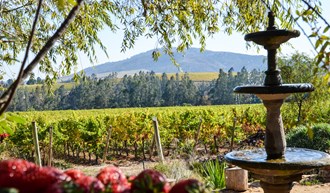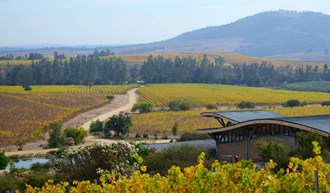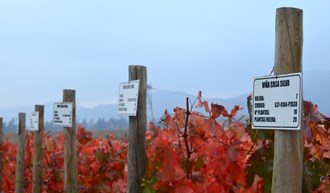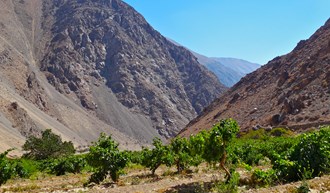largest wine producer in the world
Acres of vines planted across the country
Length in miles of the country of Chile
Percent of reds to whites produced in Chile
About Chilean Wine
Elevation
- Chile has two major mountain ranges that greatly affect its viticulture: the coastal range and the Andes mountain range.
- Chile’s vineyard elevation ranges from 400ft to 7,200ft – where some of the highest vineyards are found in the Andes Mountains of the Atacama Desert.
Climate
- Chile has been named a ‘viticultural paradise’ for its textbook mediterranean Climate. Long, dry summers are perfect for the growing season, paired with its cold, rainy winters.
- The Humboldt Current coming up the Pacific Coast of Chile brings frigid waters from Patagonia and a cool morning fog every morning that vines love (called the ‘Camanchaca’ fog).
- Large diurnal temperature shifts from day-to-night greatly influence the complexity and balance of Chile’s higher-elevation viticultural regions.
Soil
- Chile’s geological diversity creates a mosaic of soil types across its viticultural regions: including limestone, basalt, decomposed granite, schist, volcanic tuff, clay, sand and loam.
- Older than the Andes mountains, Chile’s coastal mountain range is a base of low-fertility, decomposed granite that is ideal for deep root systems and irrigation drainage.
Varietals Planted
*Denotes varieties imported by Vine Connections-
Cabernet Sauvignon*32%
-
Merlot9%
-
Carmenere*8%
-
Syrah*6%
-
Pais*6%
-
Pinot Noir*3%
-
Malbec2%
-
Other13%
-
Sauvignon Blanc*11%
-
Chardonnay*8%
-
Moscatel2%
The Wine Regions

Elqui Valley
Located at the entrance to the Atacama desert, the Elqui Valley is one of Chile’s northernmost winemaking regions. Its arid climate creates bright days and cold nights, ideal for both grape-growing and star gazing in the world’s clearest skies.
Limari Valley
The Limari Valley is Chile’s narrowest region between the Andes mountain range and the Pacific Ocean. The consistent cool winds and cold desert nights makes this northern valley an ironically ‘cool climate’ wine producer. Its highly concentrated limestone soils are ideal for Chardonnay.
Aconcagua Valley
Traditional Aconcagua wines center around Bordeaux varietals planted in the eastern Andean piedmont . Today, Aconcagua’s western coastal reaches are unearthing some of Chile’s most exciting new terroirs, with varietals like Pinot Noir and Chardonnay grown on schist and sandy-limestone.
Casablanca Valley
As Chile’s first ‘coastal’ winemaking region, Casablanca truly put cool-climate wines on the map. Inspired by California’s Carneros region, varietals like Sauvignon Blanc and Pinot Noir have thrived here, along with intriguing expressions of cool-climate Syrah.
San Antonio Valley
In contrast to its northerly neighbor Casablanca, San Antonio is on the western side of the coastal mountain range, with full exposure to the ocean. Longer, cooler growing seasons create naturally fresh and elegant styles of Sauvignon Blanc, Pinot Noir, and Syrah.
Maipo Valley
Maipo is home to the majority of Chile’s oldest wineries. The eastern Alto Maipo is where the most iconic Chilean Cabernet Sauvignon is produced. Alluvial soils, hot summer days, and cold nights create wines with balanced freshness, elegant tannins, and incredible potential for aging.
Cachapoal Valley
With its lack of a coastal area, Cachapoal winemakers have been scaling up into the mountains to find cooler temperatures. Chardonnay and Cabernet Sauvignon have had great successes there, while Carmenere still thrives in the warmer, lower central valley vineyards.
Colchagua Valley
Colchagua is a region that traditionally focused on red varietals in the central valley. In the past two decades, Colchagua's new coastal and piedmont vineyards have shown incredible quality and unique freshness. Carmenere particularly has found a sweet-spot in the alluvial/colluvial soils Los Lingues to the east.
Maule Valley
Maule is Chile’s largest area winemaking valley, located 200 miles south of Santiago. It is home to some of the oldest Pais vines, as well as Chile’s first official D.O. ‘VIGNO’: a movement inspired by the incredible quality of old-vine Carignan in Maule's dry, coastal 'secano'.
Itata Valley
Nicknamed the ‘Chilean Tuscany’, the rolling green hills Itata are home to some of Chile’s oldest viticultural history, with ancient bush vines of Pais, Muscat, and Cinsault. High rainfall and ideal growing conditions allow many vineyards to be dry farmed and organic.
Bio Bio Valley
Bio Bio has been producing wine since the 15th century, with a predominant focus on Pais table wine. In its modern chapter, Pinot Noir has shot ahead as a lead varietal along with aromatic whites. Higher rainfall, cooler temperatures and basalt soils have been the main lure for modern winemakers.
Malleco Valley
1993 was the first year Malleco was ever considered for grape growing. Traveling winemakers soon realized its similar climate to Oregon and Burgundy, and Chardonnay pioneered the valley’s volcanic-based soils. Today it produces outstanding cool-climate, ageable Chardonnays that are comparable to Chablis.









